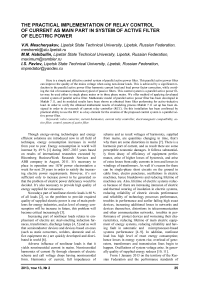Практическая реализация релейного регулятора тока как основного элемента активного фильтра электроэнергии
Автор: Мещеряков Виктор Николаевич, Хабибуллин Максим Маратович, Павлов Игорь Сергеевич
Журнал: Вестник Южно-Уральского государственного университета. Серия: Энергетика @vestnik-susu-power
Рубрика: Электроэнергетика
Статья в выпуске: 2 т.13, 2013 года.
Бесплатный доступ
Разработана простая и эффективная система управления параллельным активным фильтром электроэнергии. Такой параллельный активный фильтр электроэнергии позволяет повысить качество напряжения в электросети при работе нелинейной нагрузки. Это достигается за счет существенного снижения параллельным активным фильтром электроэнергии гармонических составляющих тока нагрузки и компенсации реактивной мощности нагрузки, при этом исключается вероятность возникновения резонансных явлений свойственных пассивным фильтрам. Данная система управления параллельным активным фильтром электроэнергии может быть использована как в однофазных, так и в трехфазных электрических сетях. Предложен способ реализации разработанной системы управления параллельным активным фильтром электроэнергии. Построена компьютерная модель активного фильтра электроэнергии в программной среде Matlab 7.11 и приведены результаты моделирования ее работы на активно-индуктивную нагрузку. Для практического подтверждения результатов математического моделирования в программной среде Matlab 7.11 создана установка по исследованию релейного регулятора тока (РРТ). На этой установке практическим путем была подтверждена возможность использования РРТ как основного элемента для создания предложенной системы управления ПАФЭ.
Вентильный преобразователь, гармоники тока, релейный регулятор тока, электромагнитная совместимость, активный фильтр, система управления активным фильтром
Короткий адрес: https://sciup.org/147158235
IDR: 147158235 | УДК: 621.316
Текст научной статьи Практическая реализация релейного регулятора тока как основного элемента активного фильтра электроэнергии
Though energy-saving technologies and energy efficient solutions are introduced now in all field of technique, energy consumption increases in world from year to year. Energy consumption in world will increase by 49 % [1] during 2007–2035 years based on results of international researches executed by Bloomberg BusinessWeek Research Services and ABB company in August, 2011. It’s necessary to place in operation one 1GW power electrostation a week for next 20 years in order to satisfy the increasing electric power requirements. However, it’s not sufficient only to increase power to be generated so that the problem of electric power deficiency would be decided. It’s also necessary to provide high quality of energy supplied for consumers.
Nowadays part of nonlinear electric loads is 60 % of all loads [2], so the problem to provide required quality of supplied electric power is one of main problems for energy industries, and as level of energy consumption will be increase in future, this problem will become critical increasingly [3].
Increasing part of nonlinear loads relates to employment of electric arc steel-smelting induction furnaces, transformers, discharge lamps [4, 5] and as well that semiconductor devices and devices based on ones (such as static converters, welders, domestic and office equipment etc.) are quickly developed and distributed in world [6].
Adverse influence of nonlinear loads is that it yields nonsinusoidal current in mains. Nonsinusoidal harmonics of current fly through elements of electric scheme and call voltage drops having nonsinusoidal form. Harmonics of current, full impedances of scheme and as result voltages of harmonics, supplied from mains, are quantities changing in time, that’s why there are some distortions in mains [7]. There is a harmonic part of current, and as result there are some perceptible economic damages. It follows substantially from decay of efficiency of equipment performance, arise of higher losses of hysteresis, and arise of extra losses from eddy currents in iron and losses in windings of transformers. As well it’s reason for there can be single-phase short circuits on the ground in cable lines, electro punctures, oscillations in electric machines, hence breakdowns and reducing lifetime of machines are. Also, lifetime of electric systems reduces because of there are increasing intension of electric and thermal wearing of insolation in electric systems, reducing reliability of electric circuits performance and reliability of technology processes performance, troubles in performance and earlier failing high exact devices, increasing additional losses in networks and devices themselves, distortions in telecommunication and other communication networks, troubles in performance of protect devices and worsening their characteristics, reducing lifetime of main electric equipment of energy systems, reducing reliability and having fault in automatic and microprocessor-based systems performance [4–9]. In addition, nonlinear load has high level of react energy consumption; hence losses in energy system rise, overload of generators, transformers and transmission lines begin to happen. Oscillations of system voltage arise. In generally quality of supplied energy reduces [10, 11].
From 1 January 2013 on the territory of the Russian Federation and the performance standards of power quality regulates GOST R 54149-2010. According to GOST R 54149-2010, all indicators of the quality of electric power can be divided into two categories – long-lasting changes and random events. For lasting changes include: the frequency deviation, slow voltage changes, voltage fluctuations and flicker, voltage unbalance of non-sinusoidal voltages in three-phase systems. As the random events considered interruptions, voltage sags, surges and voltage pulse [12].
I t sh oul d be to n ote th at n o n li n e a r di st orti ons i n ma i ns on h a n d of c o n s um e r s a re n e a rly re as on ed b y own a c t i on s o f c on s ume rs in t h e i r a re a s, a n d se l do m t h ey are brou gh t w i th m ain s [ 4, 11, 1 3]. So c on sum e r s must c on t rol i nf lu en c e th eir e qu i p me n t to mains by t h emse lv es . A n d, if it ’s n e e de d, t h ey mu s t pr ov ide compe n sa ti on of n on lin ea r di stort i on s a n d g e n era t e r e a c t i v e po we r in th e di re c t w ay on pl a c es w he re i t ’s con sum ed. S o f a r th e h a rd wa r e t o c or re c t on e or m ore r a t e of e l e ct ri c po we r qu a l i ty a n d impl i cated paramet e r s of co n s um ed re a c t i v e po we r h a s be en pa ss i v e p o w er fi lt e rs of h a r m o n ic s , c ompe n sa ti ng c a pa c i t or b a tt e r ies an d s y n ch ron ous c o m pensa t ors. Ho wev e r, a s i n pa st dec a de s th e re a re n ew a c h i e v emen ts t o de v e l op n e w h igh e ff i c i en cy po w e r semi c on d u c t o r devices that are fu l l c o n t rol l e d, s u c h a s I GBT t ra n si st ors; so i t’ s b ecome p o ss ib le to d ecid e th is is sue by m ea ns of acti ve fi lters of ele ctr ic e nerg y (AFE) [ 1 4 , 1 5 ] . N owad a ys A F E ar e t he newest a nd th e mo s t p er s p ec ti ve d e vice s to correct distortions in mai n s . T hes e d e vice s allo w t he m o st e ff ecti ve l y e n ha nc in g qu alit y o f e lectr i c energ y i n d is tr ibut in g net wo rk s . T he a cti ve fi lters ar e quic k o p er atin g d e vi ces , and s o t he y allow com p e n s ati n g f ul l r an ge o f harmon ics a nd p r o v id in g r eact i ve p ow er to mains only w h en it ’s r equir ed , comp ar ati ve l y wit h p a ss i ve harm onic s filt er s h av e a r es tr icted r a ng e o f ha rm onic s to comp e n s ate. B esides , p ass i ve f ilt er s sup p l y r eacti ve p ower to m a i ns cont in uous l y [ 16 , 1 7 ] .
T o prov i de pr otec t iv e f or m a in s f ro m n eg a t iv e i nfluence of se m i c o n du ctor c o n v e rt e rs, ma in ly pa ra l l e l ac t iv e f ilt e rs (PAEF ) a re u se d . Th ey a l l o w v e r y mu ch r e du c i ng qu a nt i ty o f h a r m o n ic pa rt of i n v e rt e r c u rre n t an d, i n fact , prov i de c om pe ns a t i ng fu l l re a c t iv e po we r consumed by them [18– 2 4]. A l l P A E F , produ c e d i n in dus t r y, h av e sim i l a r st ru ct u r e of po we r pa rt a n d suff i c i en t e ff i ci e n cy , a n d un ive rsa l i ty. Ho w ev e r, t h ey h av e a h ig h c o st of t e chn i c a l im p l em en t a ti on , a n d th ey h av e a c o m pl i c a t e d s y s t em o f c on t rol , ba se d on h i g h-p e rf orma n c e mi c roproc e ssor, e x e cu t in g c on t rol of PA E F b y m e an s of soph isti c a t e d a l g ori t hm s; th at makes them worse as reliable.
B y th e w ay, re se a rch e s t o de v e l op h i g h -p e rf orma n c e re l i a bl e c on t rol s y st ems of a c t iv e f i l t e rs are quite prospective now.
Let’s di scu ss fac i lity to de v el op sim ple s y st em , b a se d on re l ay c ont rol of cu rre n t (RC ), t o c on t rol PAEF.
Performance for active-inductive load has been modeled in software environment, called Matlab in 7.11 version, in order to analyze influence of nonlinear load to mains. Active-inductive load is represented by uncontrolled single-phase semiconductor bridge rectifier. That has been chosen as the most widely used type of nonlinear load.
Current of single-phase bridge rectifier, fed from mains, and its current harmonic range are shown as result of computer modeling in Fig. 1.
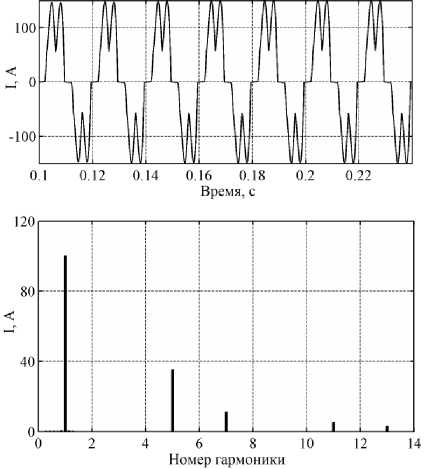
Fig. 1. Slope of instantaneous current, supplied from mains through single-phase bridge rectifier, and his range of harmonics
According to the analysis of the harmonic content of the current in Fig. 1, the value of the total harmonic distortion is 34.27 %, which is several times the normable GOST R 54149-2010 coefficient of harmonic distortion in 8 % [12].
In order to eliminate harmonic distortions, authors suggest PAEF, based on new method to get «ideal» current and to form control impulses for PAEF implemented by relay current control.
Scheme PAEF is connected to mains by, is shown in Fig. 2.
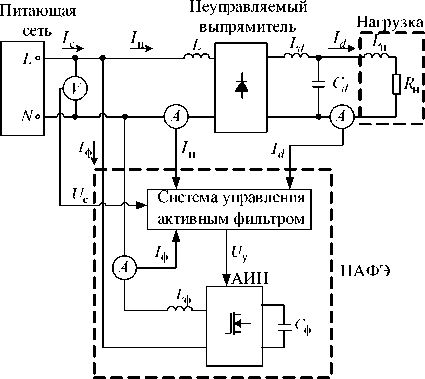
Fig. 2. Connection scheme PAEF to mains
T h e ope ra t i on pri n c i pl e of sug g est e d PAEF con t rol s yst em i s t o c o m pe nsa t e di f f e re n c e be tw e en re a l an d «idea l» l oa d c u rre n ts f ly ing t h rough a c t i v e f i l t e r a t any moment of time.
«I de a l » cu rre n t , f e d f ro m m a i n s, is de fi n e d b y equ a t ion of ba l a n c e o f po we r , c on v eye d t h ro u gh d. c . scheme into load:
Р I const cap n ,
turning through capacitor of filter via autonomous inverter of current.
Basing on data, derived by way of theoretical calculations, the computer model of PAEF, connected between uncontrolled bridge rectifier with active-inductive load and single-phase mains and in parallel way with ones, has been developed in mathematics software Matlab 7.11.
where Ucap is v ol t a g e be tw een c on de n se r a r m a tu re ,
In is c u rre n t c o n s um e d b y loa d t h rou gh bri dg e rectifier.
A ss ume po we r, c on s ume d b y l oa d, i s e qu a l f u ll power, shown as S, t h a t is s u p pl i e d f rom ma in s :
S = U c • Ic , (2)
where Ic is root-mean-square current,
Uc is root-mean- squ are v ol tage of main s.
H e n c e l e t’ s c oun t ma gn i tu de of «i de a l » c u rren t , fed from mains:
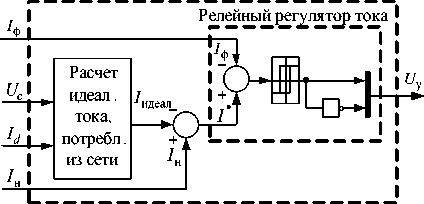
Fig. 3. PAEF control system
i=IT, ksc where ksc is rate of the bridge circuit, Id is load d.c. current.
Instantaneous ideal current is:
i* (t) = — • sin(w t + ф), ksc
where φ is se t p h ase s h if t b e twe en f e d cu rre n t a n d mains voltage.
T h e n m ak e a c o m pa re f or c a l c u l a t e d «i de a l » c u rrent with measured real load current:
*
Ai(t) = i (t) - iH(t). (5)
B y th e w ay , P A E F c o n t rol s y st em is f or me d by equations (1)–(5).
V a l u e o f diff e re n c e be tw e en « i de a l» an d real cur r e n t s is entere d i n to bl oc k of rela y cu rre n t c o n t rol ( R CC ) t og e th er w i th P A EF c u rre n t f e e dba c k . A t f i rst , R C C is co n f igu re d b y hy st e resi s v a lu e t h a t de t e r m in e s p re c i sion t o proce ss th e r ef e re n c e sign a l of cu rre n t . B y way of RCC performance there i s c on ti nu e s co mpar i n g d iffere n c e of in st an t an e ou s «i de a l» l oa d c u rre n t an d re a l l oa d c u rre n t , f ly i ng th rou gh un c on t rol l e d rec t i f i e r, w i th in st an t an e ou s c u r re n t t h rough P A E F. As r e su lt o f t h is c o m pa re, ou t put s i gn a l t o c on t rol au tonomous inverter of voltage is f or med so th a t in sta n ta n eou s PA E F cu rre n t v al u e sh o u l d be a s c l ose a s poss i b le t o v a l u e of di ff e re n ce be tw e en «i de a l » l oa d c u rre n t an d re a l on e . Th e di f f e re n c e of t h ese v a lu e s a re t ri e d t o be in h y st e res is are a by RCC . Th e n t h e f or m e d output signals are c on du ct e d t o in pu t of au t on o mous i n v ert e r of c u rre n t ( AC I) t h a t th e n f or ms i nst a n t an e ous PA E F cu rre n t as ou t c o me . Th a t cu rre n t c o m pen sat e s p os si bl e n on l in e a r dist ort i on s of l oa d c u rren t. By t h e w a y , a s re sul t , a f or m of c u rre n t , f e d f ro m m ains through «uncontrolled rectifier – P A E F » s y st em, b e come s s inu soi da l a s a ppr ox im ate as pos si bl e .
I n poi n t of v ie w o f phy sic s , c u rre n t f or m ing i s i mpl eme n t e d b y mean s en e r gy st ori ng or e n e rgy r e-
The slope of instantaneous PAEF current, obtained by way of modeling, is shown in Fig. 4.
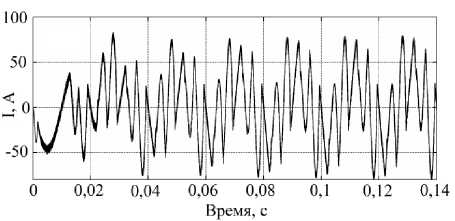
Fig. 4. Slope of instantaneous current « If » PAEF
The current, supplied from mains to load, «I» and the mains voltage «U», obtained by way of modeling, are shown in Fig. 5.
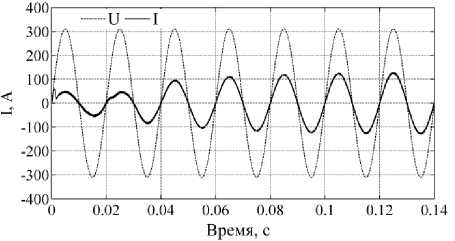
Fig. 5. Slope of instantaneous current «I» and instantaneous voltage «U», supplied from mains to «uncontrolled rectifier-PAEF» system
As it’s seen from Fig. 5, current, supplied to «un-controlled rectifier-PAEF» system, doesn’t only have a sinusoidal form, but coincide with mains voltage in phase.
Harmonics analysis of «uncontrolled rectifier-PAEF» system current, obtained by way of modeling, are shown in Fig. 6.
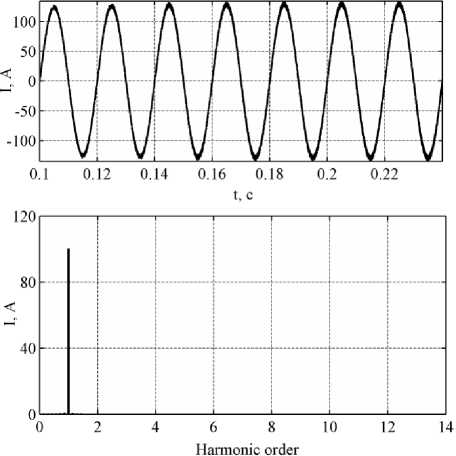
Fig. 6. Slope of instantaneous current, consumed by «uncontrolled rectifier-PAEF» system from mains, and diagram of harmonic range of current
Fro m t h e re s u l ts of th e stu d y of th e h a r mon i c composit i on o f th e c u rre n t dr a w n b y t he «uncontrolled rectifier-P A E F» s y st em f oll o w s th at t h e leve l of t otal harmonic distortion is 0.89 % , w h i ch m e e ts t h e r equirements of GOST R 54149- 2010 [12].
I n orde r t o c on f i r m re s u l t s , obt a i n e d b y mode l ing i n Matl a b 7. 11, pr a c t ica l ly, se t u p to rese a rc h R CC has been made. In fig. 7 g en e ra l v iew of se t u p i s rev e a l e d.
R epre se n t e d se t u p h as f ol l o w pa rt : «Mitsubishi PS 220 54 » po wer m od u le an d «M i tsu bish i 1200V DIP I P M ( P S220 5X) E VALU ATION BOA R D» debug b oa rd m odu le. Th ose m odules a re u se d a s a u t on o m o us inverte r o f cu rre n t . 24 V reg u l at e d po we r s u pply i s connected to ACI input. Single-ph a se l oa d i s c onn ec t e d, a s c o m bi n a t i o n of re s i st or a n d i n du c t iv e c oi l , t o A C I ou t put . R CC fu n ct i on s a re im pl eme n t e d b y program logic controller «A r du in o ME G A 2560 » based on «Atmel A tme g a 2560 » ch i p. Th e m agn i tu de an d f re qu en cy cu rre n t ref e re n c e s an d cu rre n t f e edb a c k , obt a i n e d f ro m cu rre n t s e n sor in l oa d c i rc ui t , a re en tere d t o in pu ts of c on t rol ler. C on tro l sig n a ls o f pul se w i dth m odul a t i on (P W M) f or powe r g a t es a re g i v en from MEGA 2 560 ou tpu t s. M e as u r in g o f se t u p ou t pu t v alu e s a re prov i de d by o sc i l l osc ope «H ANTE K D SO8060 » an d mu l time t e r « M ASTE C H M890F » .
Prin cipl e of ope ra t i on of se t u p i s t o f or m an d ma i nt a i n load c u rre n t i n se t fre qu e n cy a n d ma gn i tu de values by relay current control.
T h e re su l t s of RC C ope r a t ion , obt a i n e d by w ay of t h e set u p performan c e , a re re pre se n t e d i n Fig. 8.
As it follows from the slope in Fig. 8 and multimeter readings, load current is formed as sinusoid of set magnitude and frequency. By way of examination of slope in detail it can be possible to observe high-frequency rippling in relate to carrying signal of main frequency. That is result of RRC operates to form required output current curve. Besides, level of these rippling will be so low how narrow value of hysteresis area is. That’s in its turn depends on maximum of frequency generated by power gates of ACI. In other words, the higher frequency of PWM, the narrower hysteresis area, the lower level of current ripping.
So as PWM frequency increases, accuracy of RCC performance increases, too. For the being discussed set up, PWM frequency is quite low about 500 Hz, because of it’s the highest frequency Atmega 2560 can attain via discrete outputs. However, other up-to-date controllers can provide PWM in frequency up to 20 KHz. That does it possible to increase accuracy of similar set up very much.
Conclusions
By the way, during exercised theoretical inquiries and mathematical modeling PAEF, principle to compose control system for PAEF in single-phase mains has been developed. It’s been based on using of relay current control (КСС0 and the revealed way to calculate ideal load current. That allows to obtain steady operation of PAEF and to compensate harmonics range in current, supplied from mains to uncontrolled bridge rectifier that operates for active-inductive load. Also, it allows compensating dynamic reactive power of load.
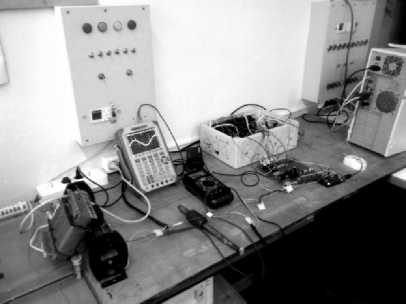
Fig. 7. General view of set up to research RCC
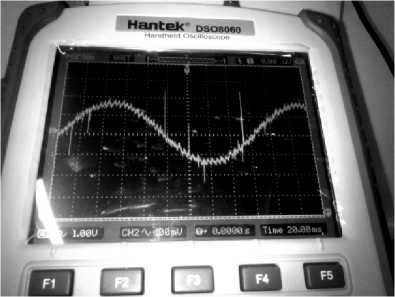
Fig. 8. The load current, displayed via oscilloscope during set up works
As practical evidence of verity of results, has being modeled for PAEF in mathematic software
MATLAB 7.11, has been developed set up to research relay current control. Facility to use RCC as main part for construction PAEF is been verified in practical way.
Also, during analyzing PAEF operation, it’s been established as well that developed PAEF control system on RCC has many advantages as simplicity of implementation, reduced cost of manufacture, easy to exploit, reliability and high-operation to performance, high quality of compensating harmonic range of current and voltage in network, and also, facility to compensate reactive power of load. Those all together with facility to regulate regimes of PAEF operation by changing hysteresis area width, provide high accommodation efficiency and universality of PAEF performance.
Hence, using PAEF, based on developed control system, for nonlinear devices, connected to singlephase mains, allows enhancing electromagnetic compatibility of nonlinear devices with mains. That would influence positively as on whole mains, so on its consumers in particularly, and so it’d provide enhancing reliability and efficiency of power supply.
Список литературы Практическая реализация релейного регулятора тока как основного элемента активного фильтра электроэнергии
- ABB insider. -2011. -№ 5. -S. 5.
- Качанов, А.Н. Особенности работы микропроцессорных систем управления в электротехнических комплексах с непрерывным технологическим процессом/А.Н. Качанов, В.Л. Кукоба//Вести высших учебных заведений Черноземья. Электроэнергетика. -2009. -№ 2(16). -С. 26-29.
- Harmonic Trend in the USA: A Preliminary Survey/I.M. Nejdawi, A.E. Emanuel, D.J. Pileggi et al.//IEEE Transactions on Power Delivery. -1999. -Vol. 14. -№ 4. -P. 1488-1494.
- Жежеленко, И.В. Высшие гармоники в системах электроснабжения промпредприятий/И.В. Жежеленко. -2-е изд. перераб. и доп. -М.: Энергоатомиздат, 1984. -160 с.
- Curtarelli, F. Current harmonic in industrial power systems arisen from AC/DC converters/F. Curtarelli, В. Deifino, G.B. Denero//ГРЕС83 Transaction-Tokyo. -1983. -P. 1016-1024.
- Климов, В.П. Проблемы высших гармоник в современных системах электропитания/В.П. Климов, А.Д. Москалев//Практическая силовая электроника: науч.-техн. сб. -2002. -Вып. 5. -С. 121-135.
- Гармоники в электрических системах: пер. с англ./Дж. Арриллага, Д. Брэдли, П. Боджер. -М.: Энергоатомиздат, 1990. -320 с.
- Гуренко, В.В. Влияние высших гармоник на точность статических измерений в электрических сетях/В.В. Гуренко//Регулирование напряжения в электрических сетях. -М.: Энергия, 1968. -С. 183-185.
- Боярская, Н.П. Влияние гармонического состава токов и напряжений на эффективность энергосбережения/Н.П. Боярская, В.П. Довгун//Вестник КрасГ АУ. -2010. -№ 4. -С. 130-134.
- Крайчик, Ю.С. Связь между реактивной мощностью и искажениями напряжений/Ю.С Крайчик//Электричество. -1998. -№ 5. -С. 71-73.
- Железко, Ю.С. Компенсация реактивной мощности и повышение качества электроэнергии/Ю.С. Железко. -М.: Энергоатомиздат, 1985. -224 с.
- ГОСТ Р 54149-2010. Нормы качества электрической энергии в системах электроснабжения общего назначения. -М.: Стандартинформ, 2012. -16 с.
- Victor, A. Treating harmonics in electrical distribution system/A. Victor, J.R. Ramos//Computer Power & Consulting. -1999. -January.
- Розанов, Ю.К. Современные методы улучшения качества электроэнергии (аналитический обзор)/Ю.К. Розанов, M.B. Рябчицкий//Электротехника. -1998. -№ 3. -С. 42-47.
- Using active power filters to improve power quality/L. Moran, J. Dixon, J. Espinoza, and R. Wallace//5th Brazilian Power Electronics Conference, COBEP'1999.
- Moran, L. Principles of active power filters, (tutorial course notes)/L. Moran, G. Joos//IEEE Industry applications Society Annual Meeting. -1998. -October.
- Алексеев, Б.А. Активные фильтры высших гармоник/Б.А. Алексеев//Электрооборудование. -2007. -№ 3. -С. 28-32.
- IEEE Std 519-1992, IEEE Recommended Practices and Requirements for Harmonic Control in Electrical. Power Systems, New York, NY: IEEE.
- Мещеряков, В.Н. Активные фильтро-компенсирующие устройства для систем регулируемого электропривода постоянного тока: моногр./В.Н. Мещеряков, А.А. Коваль. -Липецк: ЛГТУ. -2008. -164 с.
- Крутиков, К.К. Применение многофункциональных силовых активных фильтров в составе мощного частотно регулируемого электропривода/К.К. Крутиков, В.В. Рожков//Электричество. -2011. -№ 2. -С. 32-38.
- Лабунцов, В.А. Однофазные полупроводниковые компенсаторы пассивной составляющей мгновенной мощности/В.А. Лабунцов, Чжан Дайжун//Электричество. -1993. -№ 12. -С. 20-32.
- Волков, А.В. Релейное регулирование тока в активном фильтре напряжения/А.В. Волков, B.И. Бондаренко, В.А. Волков//Вiсник Кременчуцького державного полiтехнiчного унiверситету. -2007. -Вип. 4 (45). -С. 70-74.
- Боярская, Н.П. Адаптивная система формирования управляющих сигналов для активных фильтров гармоник/Н.П. Боярская, А.М. Дербенев, В.П. Довгун//Ползуновский вестник. -2011. -№ 2/1. -C. 25-29.
- Волков, А.В. Компенсация мощности искажений и реактивной мощности посредством активного фильтра с прогнозируемым релейным управлением/А.В. Волков, В.А. Волков//Электротехника. -2008. -№ 3. -С. 2-10.

